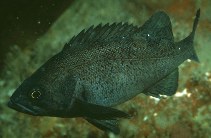| Family: |
Sebastidae (Rockfishes, rockcods and thornyheads), subfamily: Sebastinae |
| Max. size: |
53 cm TL (male/unsexed); max.weight: 1,810.0 g; max. reported age: 67 years |
| Environment: |
demersal; marine; depth range 5 - 160 m |
| Distribution: |
North Pacific: western Aleutian Islands and eastern Bering Sea, through the Gulf of Alaska, to southeast Alaska; including south to Johnstone Strait, British Columbia. |
| Diagnosis: |
Dorsal spines (total): 13-13; Dorsal soft rays (total): 15-15; Anal spines: 3-3; Anal soft rays: 8-8. Head spines weak to very weak - nasals usually present, parietals usually absent, preocular, supraocular, postocular, tympanic, coronal and nuchal spines absent (Ref. 27437). Two distinct types, (1) dark dusky - uniformly dark or dusky in color, symphyseal knob absent and, (2) light dusky - a larger, greenish brown fish, lighter ventrally, fins tinged with pink or orange, symphyseal knob present (Ref. 27437). Caudal fin slightly indented (Ref. 6885). |
| Biology: |
Found hovering in loose organized groups just above rocky reefs and along shorelines, or may rest singly upon rocky substrate (Ref. 27436). Feed by picking and seizing food items that are either drifting or suspended in the water column (Ref. 27302). Viviparous (Ref. 34817). Sold as fresh or frozen fillets; eaten as fish cakes (Ref. 27436). Captured by the nearshore jig fishery and has been reported to comprise up to 25% of the catch in the 'black rockfish' jig fishery of the northern Gulf of Alaska (citation in Ref. 53613). |
| IUCN Red List Status: |
Not Evaluated (N.E.) Ref. (130435)
|
| Threat to humans: |
harmless |
Source and more info: www.fishbase.org. For personal, classroom, and other internal use only. Not for publication.
